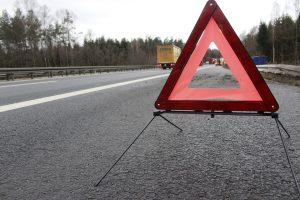 Courtesy of iii.org
Courtesy of iii.org
- Activities that take drivers attention off the road, including talking or texting on mobile devices, eating, conversing with passengers and other distractions, are a major safety threat.
- In 2014, 3,179 people died in distraction-affected crashes, based on National Highway Traffic Safety Administration (NHTSA) criteria.
- The number of state legislatures passing measures that address the problem of driver distractions continues to rise. Fourteen states and the District of Columbia ban the use of hand-held cellphones while driving; 46 states and the District of Columbia have banned the practice of texting while driving.
- A 2012 Consumer Reports survey found that 71 percent of respondents cut back on texting, talking on a handheld phone or using a smartphone while driving in the previous year. Over 50 percent of them said they were influenced to change their behavior because of state laws, up from 44 percent in a survey conducted in 2011.
THE TOPIC
Increased reliance on electronic devices has led to a rise in their use by drivers, jeopardizing the safety of vehicle occupants and pedestrians. There are two dangers associated with driving and the use of electronic devices. First, drivers must take their eyes off the road and hands off the wheel to manipulate the devices when dialing, texting and surfing the Web. Second, people can become so absorbed in their conversations and other uses that their ability to concentrate on the act of driving is severely impaired. Since the first law was passed in New York in 2001 banning hand-held cellphone use while driving, there has been debate as to the exact nature and degree of hazard. The latest research shows that using a cellphone when driving is just one of many types of distracted driving that may lead to crashes and near crashes.
RECENT DEVELOPMENTS
- Statistics: 2014: The National Highway Traffic Safety Administration (NHTSA) says that distracted driving was reported in crashes that killed 3,179 people in 2014. These fatalities accounted for 10 percent of all traffic crash fatalities in 2014.
- NHTSA reports that there were an estimated 2,955 distraction-affected fatal crashes in 2014. An estimated 431,000 people were injured in distraction-affected crashes in 2014, up 1.7 percent from 2013.
- In 2014, there were 2,955 distraction-affected fatal crashes, accounting for 10 percent of all fatal crashes in the nation, 18 percent of injury crashes and 16 percent of all police-reported motor vehicle crashes.
- There were 385 crashes in 2014 that were reported to have involved the use of cell phones as a distraction. Cell phones were reported as a distraction for 13 percent of all distracted drivers in fatal crashes.
- In 2014, 404 people died in fatal crashes that involved the use of cellphones or other cellphone-related activities as distractions.
- Research: The following is a summary of some recent research on the issue of distracted driving.
- A Highway Loss Data Institute (HLDI) analysis released in October 2014 found that although state bans on hand-held phone use by drivers have lowered phone use behind the wheel, they have not produced a similar drop in crashes. The study involved looking at the findings of National Highway Traffic Safety Administration programs conducted from April 2010 to April 2011 in Hartford, Connecticut, and Syracuse, New York, aimed at reducing talking or texting on hand-held phones. Both states ban hand-held phone use and texting. At the end of the program, researchers found that the number of drivers observed using a hand-held cellphone fell 57 percent in Hartford and 32 percent in Syracuse. HLDI analysts then compared collision claims in the counties where the cities are located–Syracuse (Onondaga County) and Hartford (Hartford County)–with the comparison counties of Albany County, New York, and Fairfield County, Connecticut, and the rest of New York and Connecticut for the period of January 1, 2009 through October 31, 2011. The analysis found no corresponding reduction in crashes reported to insurers from the program counties relative to the comparison counties. HLDI provides possible reasons for the bans’ lack of effect on accidents, including the possibility that drivers may have been distracted by something else or that drivers may have switched to hands-free calling and still may have been distracted by their conversations.
- The analysis confirms some of the results of an earlier HLDI study, released in September 2010, that found that texting bans may not reduce crash rates. The study looked at collision claims patterns in four statesCalifornia, Louisiana, Minnesota and Washingtonbefore and after text bans went into effect. Collisions went up slightly in all the states, except Washington, where the change was statistically insignificant. Adrian Lund, president of HLDI and the Insurance Institute for Highway Safety, said that the findings “call into question the way policymakers are trying to address the problem of distracted driving crashes. They’re focusing on a single manifestation of distracted driving and banning it. This ignores the endless sources of distraction and relies on banning one source or another to solve the whole problem.”
- The Centers for Disease Control and Prevention latest Youth Risk Behavior Surveillance Survey, released in June 2014, shows that about 41.4 percent of high school students reported that they texted or emailed from behind the wheel at least once during the previous 30 days. The highest rate of texting or emailing while driving, 61.3 percent, was among teens in South Dakota. The lowest rate, 32.3 percent, was among teens in Massachusetts. The survey is conducted every two years, but this year was the first time the 13,000 participants were asked about texting and emailing while driving.
- In May 2014 the National Highway Traffic Safety Administration released a study, “The Economic and Society Impact of Motor Vehicle Crashes, 2010,” which focuses on behavioral factors that contributed to 32,999 highway fatalities and 3.9 million injuries in the U.S. in 2010. The study found that those crashes cost $277 billion in economic losses and $594 billion in societal harm, for a total of $871 billion that year. A breakdown of the figures for economic losses show crashes involving distracted driving accounted for 17 percent ($46 billion).
- Drowsiness is a type of distracted driving that causes more than 100,000 motor vehicle crashes a year, resulting in 40,000 injuries and 1,550 deaths, according to the National Highway Traffic Safety Administration. A 2010 AAA Traffic Safety Foundation survey found that one in four drivers have struggled to stay awake while driving. An estimated 17 percent of fatal crashes, 13 percent of crashes resulting in hospitalization and 7 percent of all crashes requiring a tow, involve a drowsy driver, according to the AAA. Driver fatigue is of particular concern regarding operators of large trucks. In 2010 fatigue was a factor in 34 percent of fatal collisions involving drivers of large trucks, according to the U.S. Department of Transportation.
- A survey conducted by the Consumer Reports National Research Center published in the June 2013 issue of Consumer Report found that state laws that ban the use of a handheld cellphones or texting while driving in many states are effective. The December 2012 survey of 1,003 people found that 71 percent of respondents had stopped or cut back on texting, talking on a handheld phone or using a smartphone while driving in the previous year. Over 50 percent of them said they were influenced to change their behavior because of state laws, up from 44 percent in a survey conducted in 2011. The survey also found that about 25 percent of drivers were unsure of their own state’s laws.
- In March 2013 a survey was published in the latest Morbidity and Mortality Weekly Report that confirms that confirmed that the problem of distracted driving is not improving. The survey looked at both U.S. drivers and drivers in seven European countries. The study found that almost seven in 10 American drivers ages 18 to 64 said they had talked on their phones while behind the wheel in the past 30 days, and about three in 10 said they had sent text messages. The practice of driving and using cellphones appears to be far less common in the European nations surveyed. In the U.K., for example, which has strict laws regarding cellphone use while driving, only 21 percent of drivers admitted to having used a cellphone.
- State and Federal Initiatives: In 2011 the National Transportation Safety Board (NTSB) recommended that all states prohibit drivers from using cellphones, the first federal agency to call for a complete ban on telephone conversations from behind the wheel. Although the NTSB has no enforcement authority as the federal government’s leading advocate for safety, its recommendations are influential in Congress and the White House.
- The number of state legislatures debating measures that address the problem of cellphone use while driving and other driver distractions continues to rise. As of December 2015, most states have passed laws to address the problem of using a cellphone while driving. Fourteen statesCalifornia, Connecticut, Delaware, Hawaii, Illinois, Maryland, Nevada, New Hampshire, New Jersey, New York, Oregon, Vermont, Washington state, West Virginiaand the District of Columbia had laws on the books banning the use of hand-held cellphones while driving, according to the Insurance Institute of Highway Safety. Almost all of the laws have “primary enforcement” provisions, meaning a motorist may be ticketed for using a hand-held cellphone while driving without any other traffic offense taking place, according to the Insurance Institute for Highway Safety.
- Also as of December 2015, 46 states and the District of Columbia banned the practice of texting with a cellphone while driving. Most of these laws have primary enforcement provisions. The Utah law, passed in May 2009, is the toughest in the nation. Offenders convicted of causing an accident that injures or kills someone while texting behind the wheel face up to 15 years in prison. The law does not consider a crash caused by a multitasking driver as an accident but rather as an inherently reckless act, like drunk driving.
- New Technology: A number of cellphone companies are considering developing technology that will prevent people from receiving calls and texting while driving. The technology is intended to limit dangerous distractions by temporarily interrupting service so that people do not answer their phones when they are behind the wheel. One carrier has already introduced a service that automatically disables rings and alerts and sends calls to voice mail when phones are in a moving car. Some safety advocates said that it is unclear whether consumers would avail themselves of the technologies or whether the technologies would be effective.
- Insurance Coverage: Most mobile cellular service providers offer insurance for loss, theft, accidental damage and out of warranty malfunctions for a monthly fee. A report by iGR Research in May 2012 found that about 27 percent of respondents in a survey of over 1,000 U.S. consumers said they currently carry insurance on their devices.
- Court Decisions: In May 2012 a Nueces County, Texas, jury, awarded over $22 million to a woman who suffered a spinal injury when her car was hit by a Coca-Cola employee who was talking on her cellphone. The award included more than $11.5 million for lost wages, medical expenses and pain and suffering as well as $10 million in punitive damages against Coca-Cola. The defendant was on a business call, using a hands-free cellphone. Plaintiffs’ lawyers argued that Coca-Cola was aware of studies that show that the danger of cellphone use is not limited to handheld devices, but continued to back a hands-free cellphone use policy for its employees. The case at issue is Chatman-Wilson v. Cabral.



